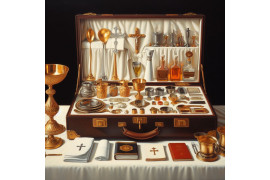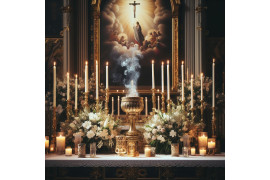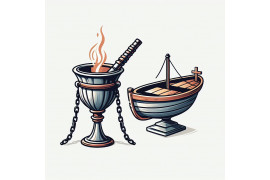During Mass, the chalice holds a special significance as it contains the precious blood of Christ. However, not just anyone can handle this sacred vessel. Only ordained priests have the privilege and responsibility of touching the chalice during the liturgy. They are entrusted with this duty to ensure reverence and respect for the Eucharist.
While deacons may assist in handling the chalice under certain circumstances, such as when there is a shortage of priests, they do so with specific permissions granted by their bishop. On the other hand, laypeople, including altar servers, should refrain from touching the chalice unless absolutely necessary.
The contrast between those who can touch the chalice (ordained priests and authorized deacons) and those who should not (laypeople) highlights the sacredness attributed to this vessel within Catholic tradition. Understanding these guidelines helps foster a deeper appreciation for the rituals and symbolism surrounding the Eucharist.
Can Non-Priests Drink from the Chalice?
In Catholic Mass, the chalice holds the consecrated wine that represents the blood of Christ. It is a sacred vessel used by priests during the celebration of Holy Communion. But what about non-priests? Are they allowed to drink from the chalice? Let's explore this topic further.
Non-priests and Drinking from the Chalice
Generally, non-priests are not permitted to drink from the chalice during Mass. The act of consuming from the chalice is reserved for ordained priests who have received Holy Orders. This tradition has deep roots in Catholic doctrine and liturgical practice.
The Church places great importance on proper reverence and respect for the Eucharist, which includes how it is distributed to the faithful. While non-priests may participate in receiving Holy Communion, they typically receive only the consecrated host (bread) rather than both species (bread and wine).
Exceptions for Extraordinary Ministers of Holy Communion
However, there are exceptions to this rule. In certain circumstances, extraordinary ministers of Holy Communion may be allowed to distribute or consume from the chalice. These individuals are specially appointed laypeople who assist with distributing Communion when there aren't enough priests available.
Extraordinary ministers of Holy Communion undergo training and receive permission from their local diocese before fulfilling their role. They play an important part in ensuring that all members of the congregation can receive Communion in a timely manner.
Emphasis on Receiving Either Species
It's important to note that while receiving both species (bread and wine) is considered a fuller sign of participation in Communion, it is not necessary for complete reception of Christ's body and blood. The Church teaches that receiving either species alone—either just bread or just wine—is sufficient for full participation in this sacrament.
This emphasis on one species being enough stems from an understanding that Christ is fully present in both the consecrated bread and wine. So, even if non-priests do not partake of the chalice, they still receive the fullness of Christ's presence in the consecrated host.
The Role of Sisters as Sacristans
Sisters play a vital role in the church as sacristans, responsible for preparing and caring for liturgical items such as the chalice. Their dedication ensures that everything is ready for the celebration of Mass and contributes greatly to maintaining a reverent atmosphere in the church.
Preparation and Care for Liturgical Items
One of the key responsibilities of sisters serving as sacristans is ensuring that all liturgical items, including the chalice, are thoroughly prepared before each Mass. This involves following specific guidelines outlined in the Roman Missal and instructions from the diocesan bishop. Sisters meticulously clean and polish the chalices, ensuring they are free from any impurities or residue.
Proper Purification and Storage
After Mass, it is crucial to handle the chalice with the utmost reverence. Sisters are responsible for purifying it according to established rituals outlined in the Roman Missal. They ensure that any remaining consecrated wine is consumed or reverently poured into a designated area known as a piscina. The chalice is then carefully washed, dried, and stored securely until its next use.
Contribution to Reverent Atmosphere
Sisters' role as sacristans extends beyond mere practical tasks; they also contribute significantly to creating a reverent atmosphere within the church. By taking care of liturgical items like the chalice with great attention to detail, they help set an example of respect and reverence for others attending Mass.
Their commitment to maintaining orderliness in sacred spaces further enhances this atmosphere. Sisters ensure that everything needed for Mass is readily available, organized neatly, and presented with dignity. From arranging vestments to setting up altar linens, their efforts contribute to creating an environment conducive to worship.
Collaboration with Priests and Deacons
Sisters work closely with priests and deacons during Mass, assisting them by providing necessary liturgical items at appropriate times. As sacrament bearers, priests and deacons are the ordinary ministers of the Eucharist. However, sisters may also be called upon to assist as extraordinary ministers when needed.
In cases where there is a shortage of clergy or an exceptionally large congregation, sisters may be authorized by the diocesan bishop to distribute Holy Communion as extraordinary ministers. In such instances, they handle the chalice with reverence and ensure that proper procedures for distributing the sacrament are followed.
The Significance of Consecrated Chalices in Mass
Consecrated chalices play a vital role in the celebration of the Holy Eucharist during Mass. These sacred vessels are blessed by a bishop and set apart for the specific purpose of holding the Precious Blood, representing Christ's presence among us. Let's explore why these chalices hold such great significance and how they are transformed through consecration.
Vessels Worthy of the Holy Eucharist
During Mass, when the bread and wine are consecrated, they become the body and blood of Jesus Christ. The chalice is used to contain the Precious Blood, which is then distributed to the faithful as a sacramental sign of Christ's sacrifice and love. As such, it is crucial that this vessel be treated with the utmost reverence and respect.
Blessed by a Bishop
To ensure their sanctity, chalices are blessed by a bishop within the Catholic Church. This act bestows upon them a special grace and sets them apart from ordinary vessels. The blessing signifies that these chalices are now dedicated solely for use in celebrating the Eucharist.
Set Apart for Sacred Use
Once consecrated, chalices are no longer ordinary cups, but vessels dedicated exclusively to containing the Precious Blood. They are not to be used for any other purpose outside of Mass or any secular activities. This separation emphasizes their sacredness and underscores their role in facilitating our encounter with Christ during worship.
Transforming Ordinary Elements
The consecration of a chalice involves more than just a simple blessing; it transforms ordinary elements into something extraordinary. Through prayer and ritual, God's grace descends upon these vessels, making them worthy receptacles for His real presence in the Eucharist. This transformation reflects our belief in transubstantiation—the changing of substance—whereby bread and wine become truly Christ's body and blood.
A Symbol of Unity
The chalice is not only significant in its role during Mass but also as a symbol of unity among the faithful. As we partake in the Eucharist, we are united with Christ and with one another as members of His body, the Church. The chalice reminds us of our shared faith and communion with each other through Christ's sacrifice.
Exploring Alternative Methods for Distributing the Precious Blood
In some situations, a different approach may be taken. One such method is intinction, which involves dipping bread into wine instead of using individual chalices. This alternative practice offers several benefits and considerations that are worth exploring.
Potential Spillage Reduction and Reverence towards Christ's Blood
Intinction provides a way to minimize potential spillage of the Precious Blood. By dipping the bread into the wine, there is less risk of accidents or mishaps that could lead to spillage. This ensures that every drop of the sacred blood is treated with the utmost reverence and respect.
Minimization of Concerns Regarding Communicable Diseases
Intinction can also help address concerns related to communicable diseases. By avoiding direct contact between multiple individuals and a shared chalice, the risk of spreading germs or infections can be significantly reduced. This becomes particularly relevant in times when there are outbreaks or heightened concerns about contagious illnesses.
Using intinction as an alternative method for distributing the Precious Blood offers certain advantages but also raises a few considerations:
Pros:
-
Reduces potential spillage of the Precious Blood
-
Minimizes concerns regarding communicable diseases
-
Ensures reverence towards Christ's blood
Cons:
-
Requires careful coordination and training to ensure proper execution
-
May require additional resources such as specialized vessels for intinction
-
Limits personal experience with receiving from individual chalices
It is important to note that while intinction has its merits, it should not replace the longstanding practice of using sacred vessels like chalices during Mass. The use of precious metal vessels, such as gold or silver, holds deep symbolic significance in representing the eternal life offered through Christ's sacrifice.
Throughout the centuries, these vessels have been used to hold and distribute the Precious Blood as a means of honoring its sacred nature. They are not merely functional containers, butt rather vessels that carry deep spiritual meaning.
Materials Used in Sacred Chalices and Purification Process
Sacred chalices hold great significance in religious ceremonies, and their construction involves the use of specific materials. Typically, these chalices are crafted from precious metals such as gold or silver. The choice of these materials is not arbitrary; rather, it symbolizes the importance and value attributed to these sacred vessels.
Using precious metals like gold or silver ensures that the chalice itself reflects the sanctity of its purpose. These metals possess an inherent beauty and shine, which adds to the visual appeal and reverence associated with the chalice. Moreover, their durability ensures that the chalice can withstand regular use during religious rituals without losing its luster.
After each use, a purification process is necessary to cleanse the chalice thoroughly. This process involves carefully rinsing it with water. The water used for purification holds immense significance as well; it must be consumed or poured onto sacred ground after purifying the chalice.
The primary objective behind this purification process is to ensure that no traces of the Precious Blood remain within the chalice from previous uses. As a result, each time a new batch of wine is consecrated during a religious ceremony, there are no remnants or mixtures from previous occasions.
To aid in this purification process, several items are employed:
Purificator
A purificator is a small cloth made specifically for cleansing sacred vessels like chalices. It serves as an essential tool for wiping away any remaining liquid after rinsing with water. This cloth plays a crucial role in ensuring that all traces of wine are removed before storing or using the chalice again.
Glass
In some cases, glass may also be used to create sacred chalices. While not as traditional as metal-based ones, glass chalices offer their unique aesthetic appeal and symbolism. They can be intricately designed with various colors and patterns while still maintaining the reverence associated with these vessels.
Enamels and Wood
In addition to metals and glass, chalices can also be adorned with enamels or made from wood. These materials provide further opportunities for artistic expression and customization. Enamels allow for intricate designs and vibrant colors, while wooden chalices offer a more organic and natural feel.
While the choice of material may vary, the significance of sacred chalices remains constant. These vessels hold a central role in religious ceremonies, representing the Precious Blood and embodying the faith of those who partake in these rituals. The careful selection of materials and the purification process ensure that each chalice is worthy of its sacred purpose.
Reflecting on Chalice Etiquette and Church Roles
In conclusion, understanding chalice etiquette and the roles within the church can help us appreciate the sacredness of the chalice during Mass. While non-priests are generally not permitted to touch or drink from the chalice, there are exceptions for extraordinary ministers of Holy Communion who may assist in distributing the Precious Blood. Sisters also play a vital role as sacristans, ensuring that the chalices are properly prepared and cared for. The consecrated chalices used in Mass hold great significance, representing Christ's presence among us.
As we explore alternative methods for distributing the Precious Blood, it is important to remember that these innovations should never compromise the reverence and respect due to this sacramental vessel. Just as different materials are used in crafting sacred chalices, such as gold or silver, so too should our approach be rooted in reverence and purity. Let us continue to honor and cherish this sacred tradition.
Frequently Asked Questions
Can I touch a consecrated chalice during Mass?
No, it is generally not permissible for anyone other than priests or extraordinary ministers of Holy Communion to touch a consecrated chalice during Mass. This is because of the sacred nature of the vessel and its association with Christ's presence.
Are sisters allowed to drink from the chalice?
Sisters who serve as extraordinary ministers of Holy Communion may be allowed to drink from the chalice while assisting with distributing the Precious Blood during Mass. However, this would depend on their specific role within their religious community and any guidelines set by their superiors.
What materials are commonly used in making sacred chalices?
Sacred chalices are often made from precious metals like gold or silver. These materials symbolize both the dignity of Christ's presence in the Eucharist and our reverence towards Him.
How do you purify a consecrated chalice?
After the distribution of Holy Communion, the chalice is typically purified by the priest or deacon. They pour a small amount of water and wine into it, which is then consumed. This process ensures that any remaining fragments of the Eucharist are reverently consumed.
Can laypeople become sacristans?
Yes, laypeople can serve as sacristans in some churches. Sacristans are responsible for preparing the sacred vessels, including chalices, before Mass and ensuring they are properly cared for afterward. It is a role that requires attention to detail and reverence for the sacred objects used in worship.



